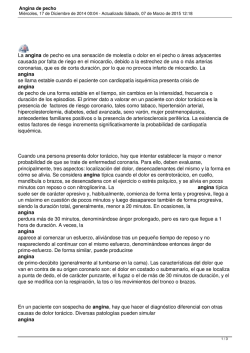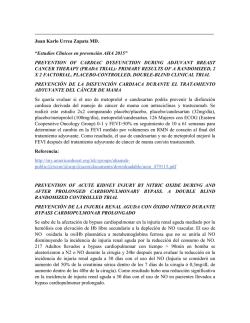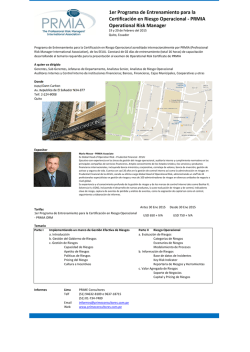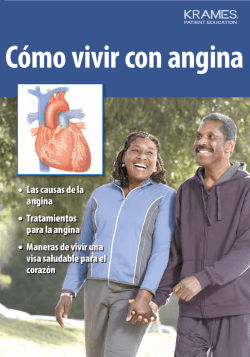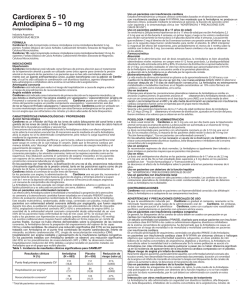
¿Cómo evaluar la enfermedad coronaria? - SOLACI
Simposio: Síndromes coronarios agudos sin elevación ST Dr. Erick Hórnez Fernández Cardiólogo Intervencionista Santa Cruz -Bolivia 6 millones consultas/año Patologías banales (osteocondritis- ansiedad) ► Múltiples causas: Patologías de alto riesgo vital (SCA – Disección Ao – TEP – Neumotórax) Hospitalizations in the U.S. Due to Acute Coronary Syndromes (ACS) Acute Coronary Syndromes* 1.57 Million Hospital Admissions - ACS 79 % UA/NSTEMI † STEMI 1.24 million .33 million Admissions per year Admissions per year *Primary and secondary diagnoses. †About 0.57 million NSTEMI and 0.67 million UA. Heart Disease and Stroke Statistics – 2007 Update. Circulation 2007; 115:69-171. DISRUPCION DE PLACA 2/3 EROSION DE PLACA 1/3 TROMBO MECANICA VASOCONSTRICCION EMBOLIZACIÓN DISTAL Obstrucción dinamica OBSTRUCCIÓN MECANICA CASS (1979) 1 Diamond y Forrester (1983) Retroesternal, irradiada a : cuello, mandíbula, brazos epigastrio o dorso 2 3 1 Dolor Retroesternal Precipitado por el esfuerzo Alivio con el reposo o nitrato en menos de 10 minutos 86 % Angina Definida Cumple con: 3 criterios 61 % Angina Probable 2 criterios Angina Atípica 0-1 criterio Dolor no anginoso 14 % Dolor no isquémico Angina Típica 90-92 % 50-75 % 15 % J Am Coll Cardiol. 1983;1:574, Letter Riesgo de Muerte o Infarto al año Clase I Angina de reciente comienzo (3 meses) Angina Progresiva Sin Angina en reposo 7.3 % Clase II Angina en reposo en el ultimo mes, pero no en las últimas 48 Hrs. 10.3 % Clase III Angina en reposo en las últimas 48 Hrs. 10,8% Braunwald E. Unstable angina. A classification. Circulation 1989;80(2):410-4. Am J Cardiol 2002;90:821-826. Dolor Torácico Isquémico SCA No Isquémico no SCA ECG SI CEST ¿ alto riesgo vital ? Reperfusión Inmediata NO Estratificación Riesgo y Tx. Disección de Aorta Embolia Pulmonar Neumotórax a tensión Dolor Precordial - SCA ECG Supra ST SCACEST Infra ST (T -) SCASEST Troponina + Normal ? No Diagnóstico Angina inestable Troponina - 06/07/2012 CABG ICP AI/IAMSEST IAMCEST Rev Esp Cardiol. 2007;60(10):1070.e1-e80 ESCALA # VARIABLES PARA CALCULAR RIESGO Clínico Bioquímico AHA/ACC 4 1 PURSUIT 4 0 TIMI 6 1 GRACE 5 2 DESENLACES VALIDADOS MACE, mortalidad, estrategia tx Mortalidad 30 días,1 año, estrategia tx MACE 14 días, estrategia tx Mortalidad 6 meses, estrategia tx Circulation 2007; 116: e148-e304 Circulation 2000;101;2557–2567 JAMA 2000;284:835–842 JAMA 2004;291:2727–2733 ACC- AHA PARÁMETRO ALTO RIESGO 1 de los siguientes: RIESGO INTERMEDIO Sin datos alto riesgo y al menos 1: BAJO RIESGO Sin datos de riesgo alto e intermedio y 1: HISTORIA Síntomas acelerados de angina en 48 hr previas Hx IAM, EVC, RVM enfermedad periférica, AAS DOLOR Angina reposo > 20 minutos Angina > 20 minutos en reposo ya resuelta, cede NTG, clase III SCC CLINICA •Edema agudo pulmonar •Insuficiencia mitral, 3R •Hipotensión, bradicardia taquicardia •Edad >75 años Edad > 70 años ECG •Angina en reposo con cambios del ST >0.05 mV •BRIHH •TV sostenida •Inversion onda T >0.2 mV •Ondas Q patológicas ECG normal en dolor MARCADORES Elevación (TnT o TnI >0.1 mg/mL) Ligera elevación (TnT >0.01 pero <0.1 ng/mL) Normal Angina instalación 2 semanas a 2 meses Circulation 2007; 116: e148-e304 Angina inestable Infarto sin elevación del ST EDAD (AÑOS) 50 60 70 80 8 9 11 12 Masculino Femenino 1 0 Sin angina o clase I-II Angina III-IV SCC 0 2 2 1 GÉNERO CLASE FUNCIONAL SIGNOS DE FALLA CARDIACA INFRADESNIVEL DEL ST Boersma E et al. for the PURSUIT Investigators. Predictors of outcome in patients with acute coronary syndromes without persistent ST-segment elevation. Results from an international trial of 9461 patients. Circulation 2000;101;2557–2567. Boersma E et al. for the PURSUIT Investigators. Predictors of outcome in patients with acute coronary syndromes without persistent ST-segment elevation. Results from an international trial of 9461 patients. Circulation 2000;101;2557–2567. Angina inestable Infarto sin elevación del ST PARÁMETRO PUNTAJE EDAD > 65 AÑOS 1 >3 FACTORES DE RIESGO 1 USO DE ASPIRINA < 7 DIAS 1 ENFERMEDAD ATEROSCLEROTICA > 50 % 1 >1 EPISODIO DE ANGINA < 24 HORAS 1 INFRADESNIVEL DEL SEGMENTO ST 1 MARCADORES CARDIACOS POSITIVOS 1 Antman EM, et al. The TIMI risk score for unstable angina/non-ST elevation MI: a method for prognostication and therapeutic decision making. JAMA 2000;284:835–42 Muerte, infarto o necesidad de RVM (%) 50 40.9 40 30 20 10 0 4.7 0/1 8.3 2 13.2 3 19.9 4 26.2 5 6/7 Número de factores de riesgo JAMA 2000;284:835–42 EDAD PRESIÓN ARTERIAL SISTÓLICA (mmHg) FRECUENCIA CARDIACA PRESENTACIÓN CLINICA CREATININA Eagle KA, et al. A validated prediction model for all forms of acute coronary syndrome: estimating the risk of 6-month postdischarge death in an international registry. JAMA 2004;291:2727–33 MORTALIDAD INTRAHOSPITALARIA CATEGORIA Bajo Intermedio Alto SCORE RIESGO MUERTE ≤ 108 109-140 ≥ 140 <1 1-3 >3 MORTALIDAD A 6 MESES CATEGORIA Bajo Intermedio Alto SCORE RIESGO MUERTE ≤ 108 109-140 ≥ 140 <1 1-3 >3 JAMA 2004;291:2727–33 ¿ CUÁL ES MEJOR ? Eur Heart J 2005; 26: 865 - 872 TIMI, PURSUIT, and GRACE risk scores: sustained prognostic value and interaction with revascularization in NSTE‐ACS Eur Heart J (May 2005) 26(9): 865-872 first published online March 11, 2005 Steg PG, FitzGerald G, Fox KA. Risk stratification in non ST-segment elevation acute coronary syndromes: troponin alone is not enough. Am J Med. 2009;122:107-8. Savonitto S, Ardissino D, Granger CB, et al: Prognostic signiicance of the admission electrocardiogram in acute coronary syndromes. JAMA 1999;281:707-713.) GRACE < 140 Class I ◦ An early invasive strategy with intent to perform revascularization (if appropriate) is indicated in UA / NSTEMI High risk clinical characteristics Positive enzymes, ST segment changes, Strongly positive noninvasive testing. Refractory angina, electical instability High risk anatomy Class IIa ◦ It is reasonable for initially stabilized high-risk patients with UA/NSTEMI (GRACE risk score greater than 140) to undergo an early invasive strategy within 12 to 24 hours of admission. For patients not at high risk, an early invasive approach is also reasonable. (Level of Evidence: B) Wright RS, et al. J Am Coll Cardiol. 2011;57:e215-367 Balance entre seguridad y eficacia Bleeding Risk Clinical Efficacy Thrombotic events Bleeding Myocardial ischemia Peri-procedural complications 2011 ESC Guideline Revision: emphasis on bleeding risk HCT (%) CrCl (mL/min) DM Female Signs of CHF PVD Heart rate SBP REF: Subherwal S. The Crusade Bleeding Score. Circulation 2009;119: REF: Subherwal S. The Crusade Bleeding Score. Circulation 2009;119: Epub CABG ICP AI/IAMSEST IAMCEST Meta-analysis for CV death or MI Study Hazard ratio (95% CI) FRISC-II (N=2457) 0.79 (0.66, 0.95) RITA-3 (N=1810) 0.75 (0.58, 0.96) ICTUS (N=1200) 0.99 (0.72, 1.35) Overall 0.81 (0.71, 0.93) 0.5 0.75 1 1.33 2 Favors routine invasive Favors selective invasive Hazard ratio Cumulative risk of CV death or MI by risk group 50 Selective invasive Routine invasive Cumulative percentage 40 High 30 20 Intermediate 10 Low 0 0 1 2 3 4 5 2077 2166 1880 1952 Follow-up time (years) SI 2746 RI 2721 2452 2485 2351 2410 2178 2235 Timing of Arteriography in UA/NSTEMI Early prevents adverse events in highest risk patients Patients with a GRACE score > 140 had higher overall event rates. The benefit continues to accumulate late after the procedure. Death, MI, Stroke Mehta et al. NEJM 2009; 360:2165-75 THROMBOSIS BLEEDING GRACE RIESGO GLOBAL CRUSADE PCI Paciente Cardiologo Resultado Objetivo Preservar el musculo
© Copyright 2024
